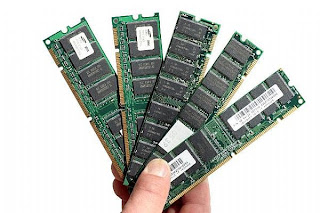
Types of RAMs
The most widely used RAMs today are SRAMs (static RAMs), which stores data in a state of a flip-flop, or DRAMs (dynamic RAMs), Flash, and EPROM, which stores data as a charge in a capacitor. Another well known type of RAM, a ROM, is a type of a RAM that has permanently enabled/disabled selected transistors by using a metal mask. ROMs thus cannot store any further charges.
Flash
In today's computers, RAMs are shipped in a form of module known as DRAM modules or memory modules. It is about the size of a chewing gum and with the Plug n Play technology, these can easily be replaced by taking it out of the port and replacing it with a new one. Not to forget, there is also an extremely small amount of RAM (known as SRAMs) within CPUs, motherboards, hard
RAM Swapping
Sometimes people will need more memory than what the RAM installed can offer during intensive application cycles. During these sessions, the computer will conduct a task known as swapping. This is when the computer temporarily uses the hard drive space in place of the memory. Thrashing is the term for constantly swapping, but as the name's connotation suggest, constant thrashing can decrease the overall system performance. More RAM being added can reduce the swapping rate.
RAM is an abbreviation for Random Access Memory. It usually refers to "temporary" memory, as when the system is shut down, the memory is lost. This is why the memory is referred to as being "random," as any piece of information can be circulated through the memory regardless of its location and its relation to any other information within the RAM. The first of the many RAMs to come in the future was created in 1951 and was used until the late 1960s and early 1970s
Security Concerns
SDRAMs are known to not fully shut off when the power is cut. Instead, the stored memory is faded away. While this fading away only takes seconds in a normal room temperature, which is not the case in lower temperatures, which then the fading away can take up to minutes. Therefore, encrypted information could potentially be leaked as it is still stored in the memory.
Recent Developments
Currently non-volatile RAMs are under development, which will mean that memory can still be stored when the power is shut off. The more advanced step yet to have been taken was in 2004 when Nantero developed a fully functioning carbon nanotube memory type holding 10 GB. Recently in 2006, "Solid State Drives" with sizes of 150 GB and a faster speed than the normal hard drives have been created.

No comments:
Post a Comment